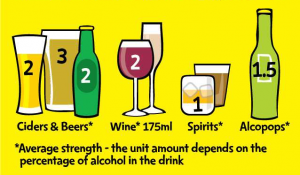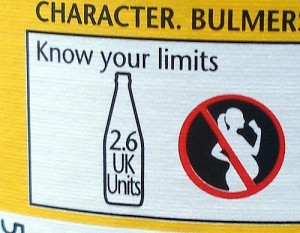
Last month the UK Chief Medical Officers (CMOs) published new guidelines for alcohol consumption. These are the first new guidelines since 1995 and are based on the latest evidence on the effects of alcohol consumption on health.
The guidelines provide recommendations for weekly drinking limits, single drinking episodes and recommendations for pregnant women, drawing heavily on the Sheffield Alcohol Policy Model, which uses the most up to date evidence on both the short- and long-term risks of alcohol.
What are the new guidelines?
Guidelines for weekly drinking
For the new weekly drinking guidelines, the CMOs recommend that:
- It’s safest for both men and women to not regularly drink more than 14 units of alcohol per week;
- It’s best to spread these units over 3 days or more;
- Having several drink-free days each week is a good way of cutting down the amount you drink;
- The risk of developing a range of illnesses increases with any amount you drink on a regular basis.
There are two key changes here from the guidelines we’ve been used to:
First, there’s no difference in recommendations for men and women. This is because there is increasing evidence that although women are more at risk from the long-term health effects of alcohol, men are more at risk from the short-term effects of drinking (they’re more likely to expose themselves to risky situations while drinking).
Second, there is an explicit statement that there is no ‘safe’ level of alcohol consumption. Over the past 21 years, the link between alcohol and cancer has become much clearer. For example, we now know that while the lifetime risk of breast cancer is 11% among female non-drinkers, the lifetime risk for a woman drinking within the new guidelines is 13%. A woman drinking over 35 units a week increases her risk of breast cancer to 21%.
In their report, the CMOs are also at pains to point out that the evidence supporting alcohol’s protective effects on ischaemic heart disease is now weaker than in 1995. Furthermore, any potential protective effect of alcohol is mainly observed among older women at very low levels of consumption. Previously some have used this to claim that drinking is better than abstinence – the new guidelines refute this.

The new guidance says it’s safest for men and women to drink no more than 14 units each week.
Guidelines for single drinking episodes
The new guidelines are the first to provide guidance on drinking on single occasions, recommending drinkers:
- Limit the total amount consumed on any occasion;
- Drink slowly, with food and alternating with water;
- Avoid risky places and activities and ensure they have a safe method of getting home.
These new recommendations reflect the fact that many alcohol consumers may drink heavily on occasion and provide guidance to avoid the risk of injury and ischaemic heart disease which increase with heavy drinking.

Heavy drinking episodes are linked with a higher risk of injury.
Guidelines for drinking during pregnancy
The new guidelines suggest that:
- The safest approach for pregnant women is not to drink alcohol at all, to keep risks to the baby to a minimum.
- Drinking during pregnancy can lead to long-term harm to the baby, with the risk increasing with the more alcohol consumed;
- The risk of harm to the baby is likely to be low if a woman has drunk only small amounts of alcohol before she knew she was pregnant or during pregnancy.
The CMOs report that while the evidence on the effects of low alcohol consumption during pregnancy remains ‘elusive’, taking a precautionary approach is most prudent when it comes to a baby’s long term health. However, given the elusive evidence, the guidance is also careful to note that mothers should not be too concerned if they have drunk early in their pregnancy, as this kind of stress may be even more harmful to the developing baby.

Pregnant women are advised not to drink alcohol at all.
A note on risk
These recommendations are based on a level of alcohol consumption which confers a 1% lifetime risk of death from alcohol. Their purpose is therefore to minimise risk from alcohol, rather than eliminate it. Indeed, the guidelines explicitly state that there is no safe level of alcohol consumption. So what does a 1% lifetime risk mean and how does this compare to other health behaviours?
Lifetime mean risks
- Being killed through BASE jumping (0.3%);
- Being killed in a car accident (0.4%);
- Being diagnosed with bowel cancer from eating three rashers of bacon every day (1%);
- Dying from an alcohol related disease, if drinking within the new guidelines (1%);
- Smokers dying from a smoking related disease (50%, although new estimates suggest that this may be as high as 67%).
Put in the context of smoking, the risk posed by drinking within the new guidelines seems tiny (although it’s still more risky than BASE jumping!) However, it’s important to note that alcohol consumption and smoking are quite different. Alcohol consumption is perceived as normal in our society and is much more prevalent than cigarette smoking. By contrast, the acceptability of smoking is reducing and unlike social alcohol consumers, smokers are constantly being told to quit smoking.
This 1% risk level is that which is deemed ‘acceptable’ by the CMO. However, everyone will have a different ‘acceptable’ level of risk, which depends in part on how much pleasure is obtained from drinking. While some will think that increasing their risk of death from alcohol to 5% is acceptable, others will not accept any risk and will use these guidelines to cut out alcohol completely.
Criticisms of the new guidelines
As expected, the ‘nanny state’ criticism has been bandied around in pubs, on message boards and on social media since the publication of these guidelines. Others claim that these new guidelines are simply scaremongering. However, it’s important to remember that these are recommendations, not rules.
The last word must go to CMO Professor Dame Sally Davies, who addressed this criticism by saying that:
What we are aiming to do with these guidelines is give the public the latest and most up- to-date scientific information so that they can make informed decisions about their own drinking and the level of risk they are prepared to take.

What do you think? Are these new guidelines useful? Will they help reduce alcohol related harm?
Links
Primary paper
Department of Health (2016) Health risks from alcohol: new guidelines. Open Consultation, 8 Jan 2016 (Consultation closes on 1 April 2016)
Department of Health (2016). Alcohol Guidelines Review – Report from the Guidelines development group to the UK Chief Medical Officers.
Other references
Centre for Public Health (2016). CMO Alcohol Guidelines Review – A summary of the evidence of the health and social impacts of alcohol consumption. Liverpool John Moores University.
Centre for Public Health (2016). CMO Alcohol Guidelines Review – Mapping systematic review level evidence. Liverpool John Moores University.
Department of Health (1995). Sensible drinking: Report of an inter-departmental working group.
Photo credits


As of 9th Feb new alcohol guidelines: what you need to know https://t.co/TEIKwSFr06 via @sharethis
New alcohol guidelines: what you need to know https://t.co/a8sGmiZUyT #MentalHealth https://t.co/y4mLEW1EQ7
We’ve blogged about the evidence behind the new @DHgovuk #alcohol recommendations https://t.co/9CMYLum1CH https://t.co/1P3KxsgYny
@Mental_Elf @OliviaMaynard1 good review, so is alcohol the new tobacco ?
@Mental_Elf useful summary, thank you.
@Mental_Elf great blog but can i ask your take on the issue of dietry interaction- for instance is med diet a moderator/ mediator of effect
My new @Mental_Elf blog on the new(ish!) alcohol guidelines. Do you think they’ll change your drinking behaviour?
https://t.co/1REyZEUVdX
@OliviaMaynard17 @Mental_Elf interesting article. Is there a move to get units clearly reported on pub menus/bottles, like calories on food?
@LindseyAHines @Mental_Elf Thanks. APPG on Alcohol Misuse 2015 manifesto https://t.co/iaeowG1adm recommends unit labelling, but no move yet
@LindseyAHines @Mental_Elf We’re conducting some experimental research now looking at the behavioural impact of unit and calorie labelling
@OliviaMaynard17 @LindseyAHines @Mental_Elf ∗cool∗ ?
@OliviaMaynard17 @Mental_Elf I think they’re hopelessly out of touch. Calorie/ sugar content would be more effective for reaching women.
@OliviaMaynard17 @Mental_Elf Nice, but comparing drinking at guidelines with average risk for current smokers is hard to get your head round
@OliviaMaynard17 @Mental_Elf A more consistent comparison would be risk from smoking *at a given level*.
@OliviaMaynard17 @Mental_Elf Also worth noting that guidelines for smoking are 0, so implicit advice is that *more* risk from alcohol is OK.
In your section on criticisms, you missed out the most important criticism, namely that the guidelines are not really based on actual evidence. They are rather based on mathematical modelling. Mathematical modelling is a rather precarious way of getting at an answer, as the results of the model can be very sensitive to the assumptions you put into it. Not all those assumptions are well described, so we can’t be sure how reasonable they are, and some of the ones that are described are completely unreasonable.
I’m afraid these guidelines have the feel of being written after someone decided they wanted guidelines to recommend lower limits, and then shoe-horning the evidence to fit.
I have blogged in some detail about this here:
http://www.statsguy.co.uk/new-alcohol-guidelines/
Today @OliviaMaynard17 takes us through the recent @DHgovuk safe drinking recommendations https://t.co/9CMYLum1CH #alcohol
RT @Mental_Elf: Are the new government alcohol guidelines actually based on reliable evidence? @OliviaMaynard17 explains https://t.co/9CMYL…
I read the NHS documents for links to evidence, meta-analyses etc with very little luck. Fortunately, Adam Jacobs, in your comments, did a better job of investigating
http://www.statsguy.co.uk/new-alcohol-guidelines/
It seems misguided to issue advise on the basis of such a poor model – why do it?
Summary of the new alcohol guidelines here: (https://t.co/GI76oydkSP) @OliviaMaynard17 @Mental_Elf @BristolTARG
New alcohol guidelines: what you need to know https://t.co/VDnNkwDVo1 via @sharethis
New #alcoholguidelines: what you need to know https://t.co/YhEuIcobbD An overview from @Mental_Elf
New @DHgovuk guidance shows increased risk of #BreastCancer linked to #alcohol consumption https://t.co/9CMYLum1CH https://t.co/T1V3UuJKTI
New alcohol guidelines: what you need to know https://t.co/XbD3eHnqqI
Don’t miss – New alcohol guidelines: what you need to know https://t.co/9CMYLum1CH
New @DHgovuk guidance says safest approach for pregnant women is not to drink alcohol at all https://t.co/9CMYLum1CH
Good summary of recent guidance on alcohol consumption https://t.co/BZA3TuKkYM by @OliviaMaynard17 Interesting comments below also.
New alcohol guidelines: what you need to know https://t.co/6wR2aZ6BNx via @sharethis
Lo nuevo que necesitas saber acerca del consumo de #alcohol https://t.co/bQdy8WdTu3 vía @Mental_Elf #Psicología #Asturias
New alcohol guidelines: what you need to know https://t.co/qZGxPQ7krw via @sharethis
Most popular blog this week? It’s @OliviaMaynard17 New alcohol guidelines: what you need to know https://t.co/9CMYLum1CH
How well can you express your feelings? We are investigating on how emotion expression and understanding relate to drinking and personality.
If you are a social drinker, having consumed at least 6 standard drinks of alcohol in the last 12 months, and are between 18 and 30 years, you are invited to participate in this study. You only need to complete this 30-minute online survey one-off.
It is completely anonymous and confidential. By participating you can enter the draw to win one of four $50 Coles Group & Myer Gift Cards! Thank you in advance!
URL: https://goo.gl/FKl4g8